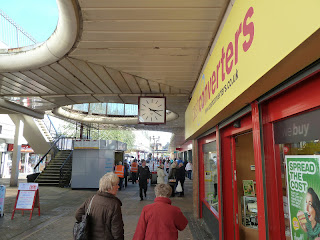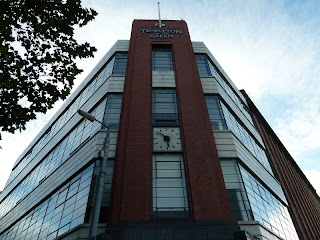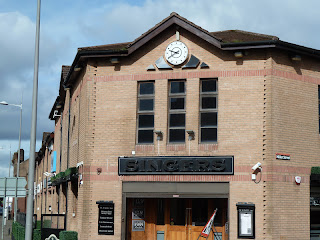Part 5 of the Glasgow jaunt, and on to the Great Western Road.
This clock is on what is now a branch of Costa, on the junction with Otago Street. It is only now looking at the photograph that I have realised that this is not really a clock at all. It was certainly stopped, but you can see from the picture how the hands are fixed into position and do not have a central mechanism to make them go round. It looks nice, but it is intriguing why this feature has been retained rather than say a Costa logo - I can only assume that it is something to do with planning regulations.
In the background of the picture below you can see another clock which we will come to in a moment.
But first a trip down Otago Street itself and to this "Antique Lighting and Furniture" shop, with a battered looking and non-functioning clock.
The close-up picture shows just what a bad condition this clock is really in. It is certainly in no condition to go "ping"!
Back on to the Great Western Road (and for information this and the previous two clocks can be found a short distance from Kelvinbridge station on the excellent Glasgow underground system).
This is Coopers on the junction with Bank Street, with a clock that is actually working. And a slightly unusual pattern on the clockface. The book "The Buildings of Scotland - Glasgow" (Penguin Books 1990) describes the tower with "clock faces set in panels with linking swags at cornice level, a cast-iron balcony, classically detailed lucarnes set into a truncated conical roof with fish-scale tiles and a crowning cupola strongly reminiscent of a stone Coca Cola bottle".
The sun is shining on Woodlands Road, and on this building on the corner of West End Park Street.
Quite a nice clock, and a return to the blue and gold theme which we saw in the city centre.
Off now to Clydebank. This building is the recently restored town hall, originally built in 1902.
The clock is by Gilett and Johnston of Croydon, and therefore a long way from its place of origin.
In my short stop in Clydebank I only expected to find the town hall clock, but there are two further ones on the same road (Dumbarton Road) on more modern buildings.
The first is on Singers........
.......and the second is on the premises of PRG Solicitors. I particularly like the overall design of the Singers clock as it fits well with its surrounding ornamentation. The PRG clock is much more clumsy in the way that it is fixed to the building.
Moving eastwards along the Clyde, and to Stobcross Quay just to the west of the Scottish Exhibition and Conference Centre. This tower is right by the heliport (good for navigating by I suppose), and I assume was some form of accumulator tower. As you can see, the clock is not currently working, with different times shown on each of the faces.
Just two more clocks in this episode. First is that of Harvey's Funeral Directors on St Vincent Street, with a complete set of arabic numerals.
Second is this building on the junction of Dumbarton Road and Cooper's Well Street.
The clock is close to Kelvinhall underground station, which is the stop for the Kelvingrove Art Gallery.....
.....which is nothing to do with clocks, but which has a fantastic art collection (including the truly remarkable Christ of St John on the Cross by Dali, and this painting by Alison Watt, one of my favourite artists). The cafe also serves one the finest lemon tarts to be found anywhere.































































